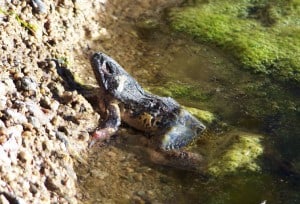Share this article
Lowland leopard frogs fight off deadly pathogen
In Arizona, some populations of lowland leopard frogs’ immune systems are working overtime to fight off the deadly pathogen that causes the chytridiomycosis, a disease that is devastating amphibians in the southwestern United States.
In a recent study published in the journal Proceedings of Royal Society B: Biological Sciences, researchers looked at the frogs’ immune system genes that make some of them resistant to the deadly disease.

Savage photographs frogs in a pond. ©Dennis Caldwell
In a 2011 study conducted as part of her Ph.D. research, lead author Anna Savage — who is now an assistant professor in the Department of Biology at the University of Central Florida — completed a lab experiment that showed a correlation between certain immune gene alleles and whether the lowland leopard frogs (Lithobates yavapaiensis) survived being infected with the fungal pathogen Batrachochrytrium dendrobatridis (Bd) that causes the disease. After controlling for environmental variables such as heat or other species coexisting in their populations, the researchers were able to isolate an immune system allele — which they named “allele Q” — that was present in frogs that did not develop the disease when exposed to the fungus.
As part of this more recent study, Savage took the experiment out of the lab and into the field. She looked at eight populations in their natural environment and studied alleles associated with survival at an individual and population level. “We sequenced the same immune system genes and looked for the same patterns of allele susceptibility,” Savage said. “We were excited that we indeed found the exact same pattern as well additional patterns.” Individuals and populations with allele Q were infected but did not suffer from the disease, she said.
However, she added, there was one striking difference between the two studies. In the lab, frogs that were heterozygous for allele Q — meaning they had one allele Q and a second non-Q allele — had higher survival rates compared to frogs with two copies of the allele Q genes. But in the field study, there was no relationship between heterozygosity and survival.
“Our hypothesis was that if a frog has more different “flavors” of a gene, it will be able to fight off more pathogens,” she said. “Heterozygosity would be associated with higher survival.” In the field, they found allele Q was predictive of survival, but it didn’t matter if there were two different copies of the gene or if both were the same.

A dead lowland leopard frog that died from the chytridiomycosis disease.
Savage is also in the process of applying the information from her study to the Chiricahua leopard frog (Lithobates chiricahuensis), a species that is listed as threatened under the Endangered Species Act. Savage chose to study lowland leopard frogs since they are more abundant and therefore better suited for studying disease susceptibility in frogs in the Southwest.
In the future, however, she hopes to look at the endangered frog. “From the start, I always had an interest in applying this to more threatened species such as the Chiricahua leopard frog,” she said.
Savage is currently working with the Phoenix Zoo’s Conservation Center to complete a study on Chiricahua leopard frogs that are raised every year at the zoo’s facility as part of a 20-year-old head-start program. So far, she has looked at the immune genotypes of zoo-raised Chiricahua leopard frogs before releasing and recapturing them in the winter when chytrid fungus causes the most damage. Savage plans to look at whether frogs with certain immune gene variants survived. “If so, this can be a powerful management tool,” she said.
Savage added that once they determine which immune genes are necessary for the frogs to become resistant to the disease, it may be possible to start a captive breeding program or select populations with high rates of beneficial immune variants for the zoo’s captive breeding program. Releasing these frogs into the wild could help increase disease resistance in natural populations.
“This can give them an extra head-start before putting them into the population,” she said.
Header Image: A lowland leopard frog. ©Anna Savage








